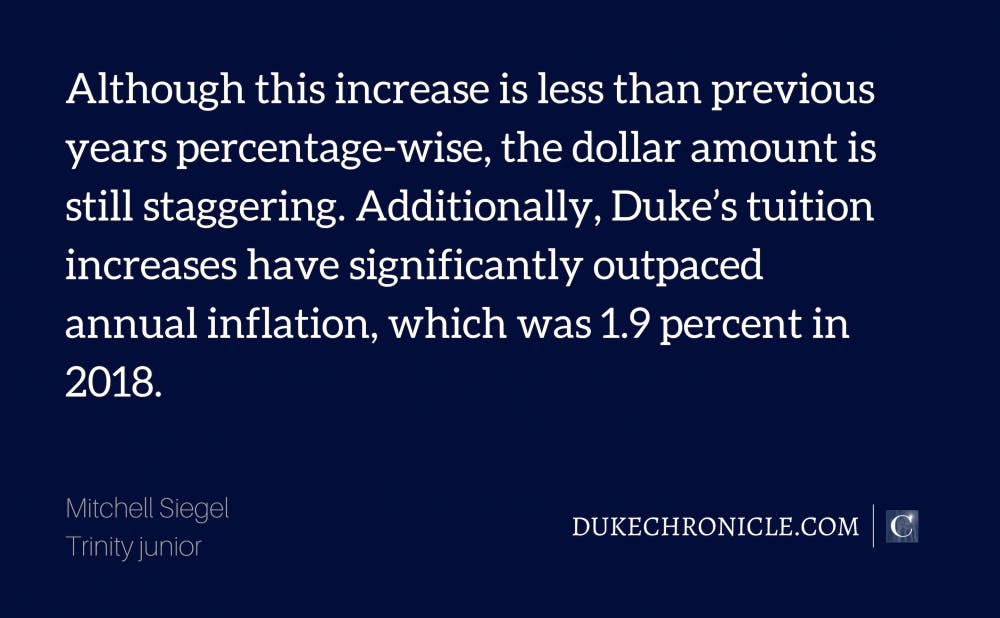Duke is partaking in a national crisis, and it’s only getting worse. It’s contributing to the enormous cost crisis engulfing the higher education system.
Last week, the Board of Trustees approved a 3.9 percent increase for undergraduate tuition for the 2019-2020 school year, raising the total tuition to $55,880. The total cost of attendance will increase by 3.7 percent to $73,519. Although this increase is less than previous years percentage-wise, the dollar amount is still staggering. Additionally, Duke’s tuition increases have significantly outpaced annual inflation, which was 1.9 percent in 2018.
No wonder the median family income of a Duke student is $186,700. Without sufficient loan support, financial aid or scholarship compensation, Duke students must have the ability to bear a massive financial burden. Plainly speaking: Duke is really, really expensive.
Nineteen percent of Duke students come from families whose income ranks in the top one percent, putting Duke third in this category compared to America’s elite universities. This is approximately the same proportion of students who come from the bottom 60 percent of income. Since the early 1980s, the breakdown of socioeconomic representation at Duke has remained stable. A 2017 study analyzed by the New York Times found that many of America’s elite institutions are becoming more economically segregated over time.
For a university that prides itself on diversity and inclusion, Duke’s tuition increases are not helping its cause, particularly in a socioeconomic sense. Unfortunately, it’s not the sole offender among private nonprofits.
Accounting for inflation, the cost of an undergraduate degree has spiked by 213 and 129 percent since the late 1980s at public and private schools, respectively. Why is college so expensive? It’s complicated.
The Organization for Economic Cooperation and Development reports that the U.S. spends more on college than almost any other country—nearly $30,000 per student. Based on the report, the cost of attendance per student at Duke is about four times the amount spent per student in the average developed country.
Because college students in the U.S. are more likely to live away from home, higher expenditures for student welfare services such as housing, meals, health care and transportation are required. Duke’s operating budget for this academic year was $2.7 billion, with a significant portion going to renovation and construction projects. Over the past few years, Duke has become notorious for fancy amenities and accommodations that lead to increased costs.
Despite the luxuries provided by American universities, the data suggests that the vast majority of spending is incurred from educational operations such as salaries for staff and faculty. These costs total $23,000 per student, which is more than double the amount in Finland, Sweden and Germany. A lot of the difference comes from paying non-teaching staff such as athletic employees, lawyers, diversity managers, admissions and financial aid officers, and food-service workers.
Economically speaking, college is a service rather than a good. The price doesn’t decrease with advances in technology. Furthermore, rankings from media companies such as U.S. News & World Report have likely contributed to a surge in demand for degrees, which are often valued based on the reputation of the institution. Duke’s ranks 8th on this list and often attains a similar rank from other publications. The Class of 2022 had 37,302 applications. These numbers indicate that Duke might be charging so much in part because it can get away with it.
The changing labor force is also putting pressure on students to obtain degrees. Over 3 million people in the U.S. are expected to receive a degree by the end of the academic year. This number is expected to increase as Georgetown University finds that by 2020, “65 percent of all jobs in the economy will require postsecondary education and training beyond high school.” Simply put, economic needs are making college degrees more popular.
Fortunately, Duke students often receive a large return on investment for their education. The Wall Street Journal’s annual ranking release found that Duke holds the top spot for student outcomes, which is, “based in part on how much of a difference they make in what their graduates earn 10 years after enrollment.” Some would argue that combined with the financial aid compensation, a Duke degree can be earned at a major discount. However, as costs continue to rise, middle class students who are ineligible for aid are strapped with a burden that could shrink their representation at Duke.
On top of the cost of tuition itself is the cost of financing that tuition. On average, students who attended American universities graduate with an average of $37,172 in student loan debt. Collectively, this adds up to $1.5 trillion. These crushing loans apply onerous restrictions on graduates when it comes to living expenses, career decisions and personal finances. Duke students are surely not immune from this daunting impediment.
Although Duke is committing to investing more in financial aid, tuition increases are not helping expand its reach. Duke should strive to differentiate itself from other elite institutions by making attendance more affordable.
We used to say that you couldn’t put a price on education. However, with the university cost crisis spiraling out of control, many of us will be forced to.
Mitchell Siegel is a Trinity junior. His column, Truth Be Told, runs on alternate Thursdays.
Get The Chronicle straight to your inbox
Signup for our weekly newsletter. Cancel at any time.
Mitchell Siegel is a Trinity sophomore. His column, "truth be told," runs on alternate Wednesdays.

